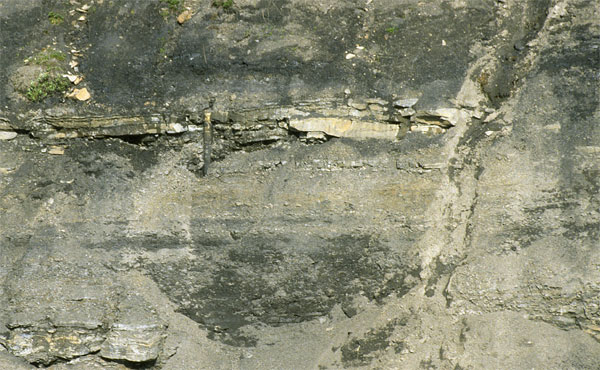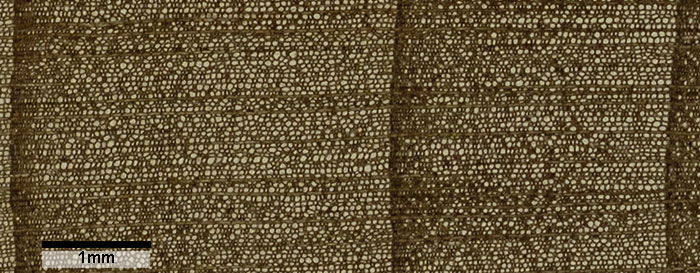The Lost World of the Arctic
| A Warm Arctic | Climate Change | Polar Light Regime | Arctic Forests | Arctic Dinosaurs |
|---|
Arctic Forests
|
Fossil Wood

The piece of fossil wood above is from the middle Paleocene (Selandian) Sagwon section, northern Alaska. The tree it comes from lived 60 million years ago at an ancient latitude of approximately 80 °N. The rings it displays are typical of those produced under a polar light regime where each annual ring has a wide zone of summer wood ('early wood') followed by a thin band of darker 'late wood' produced during the fall when day length decreases rapidly over a few weeks towards the continuous darkness of winter. Sometimes if growth conditions deteriorate briefly during the summer a false ring is produced. In fossil woods it is quite common to find some rings crushed or compressed during the fossilization process. |
There is an abundance of fossil wood in the Arctic. Most fossil wood is found as isolated pieces of trunks, branches or twigs, but preserved standing tree bases rooted in fossil soils (paleosols) are also common. Groups of such tree bases in their growing positions are termed 'fossil forests' and there are many such forests preserved in the Cretaceous rocks of Alaska and Russia. These are direct evidence that there were forests growing near to the ancient North Pole. The image to the right shows a typical example of a tree base preserved upright in growth position. The opper portion of the stump lies on its side to the right on the ledge and shows an eroded top (now facing the upright portion). Further excavation showed that this tree was rooted on a carbonaceous shale and was preserved by a sudden influx of fine sand. This sand shows wavy bedding and some dewatering structures as further evidence of its rapid deposition, most probably during a storm-related flood event. The eroded upper portion of the trunk appears to have decayed before carbonate minerals infilled the cells spaces and preserved the trunk that was buried below the sediment surface. Moreover the decay of the exposed part of the tree suggest that it was in the order of several decades before another influx of sediment completed the burial process. The width of the preserved logs varies from approximately 0.5 m in the Cenomanian rocks of the Nanushuk Formation in northern Alaska, to barely 20 cm diameter in the Maastrichtian part of the Prince Creek Formation, also in northern Alaska. From this we can deduce that conditions for tree growth were less favourable in the Maastrichtian than the Cenomanian, but more information of these conditions can be obtained by looking at the tree rings within such fossil wood. |
 |
||
|
An Albian tree in growth position exposed in the Kukpowruk Formation along the Kukpowruk River, N. Alaska. | ||
The photograph above shows a slender upright tree preserved in a coarsening upward succession of silty mudstones to fine sands representing overbank sediments, possibly a crevasse splay. The section is exposed along the Kokolik River, N. Alaska. The image to the right shows the same tree in more detail. |
 |


